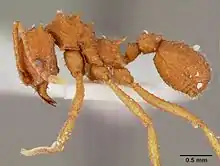Trachymyrmex
Trachymyrmex is a genus of fungus-growing ants in the subfamily Myrmicinae. The genus is mainly tropical in distribution, with most species being found in Central and South America.[3]
| Trachymyrmex | |
|---|---|
 | |
| Trachymyrmex septentrionalis worker | |
| Scientific classification | |
| Domain: | Eukaryota |
| Kingdom: | Animalia |
| Phylum: | Arthropoda |
| Class: | Insecta |
| Order: | Hymenoptera |
| Family: | Formicidae |
| Subfamily: | Myrmicinae |
| Tribe: | Attini |
| Genus: | Trachymyrmex Forel, 1893 |
| Type species | |
| Atta septentrionalis[1] McCook, 1881 | |
| Diversity[2] | |
| 48 species | |
The queens of the species appear to mate with only one male on their nuptial flight.[4]
Species
A number of species were moved from Trachymyrmex based on molecular phylogeny by Solomon et al. 2019. Of the species formerly included, nine were retained in Trachymyrmex, while 31 of the species were moved to the new genus Mycetomoellerius, and an additional nine moved to Paratrachymyrmex.[5]
Trachymyrmex species
- T. arizonensis (Wheeler, 1907)
- T. carinatus Mackay & MacKay, 1997
- T. desertorum (Wheeler, 1911)
- T. nogalensis Byars, 1951
- T. pakawa Sánchez-Peña et al, 2018
- T. pomonae Rabeling et al, 2007
- T. saussurei (Forel, 1885)
- T. septentrionalis (McCook, 1881)
- T. smithi Buren, 1944
Species moved to Mycetomoellerius
- T. agudensis (Kempf, 1967)
- T. atlanticus (Mayhé-Nunes & Brandão, 2007)
- T. cirratus Mayhé-Nunes & Brandão, 2005
- T. compactus Mayhé-Nunes & Brandão, 2002
- T. dichrous Kempf, 1967
- T. echinus Weber, 1938
- T. farinosus (Emery, 1894)
- T. fiebrigi (Santschi, 1916)
- T. gaigei (Forel, 1914)
- T. guianensis Weber, 1937
- T. haytianus (Wheeler & Mann, 1914)
- T. holmgreni Wheeler, 1925
- T. iheringi (Emery, 1888)
- T. isthmicus Santschi, 1931
- T. ixyodus Mayhé-Nunes & Brandão, 2007
- T. jamaicensis (André, 1893)
- T. kempfi Fowler, 1982
- T. oetkeri (Forel, 1908)
- T. opulentus (Mann, 1922) (jr syn *T. wheeleri)
- T. papulatus Santschi, 1922
- †T. primaevus Baroni Urbani, 1980
- T. pruinosus (Emery, 1906)
- T. relictus Borgmeier, 1934
- T. ruthae Weber, 1937
- T. squamulifer (Emery, 1896)
- T. tucumanus (Forel, 1914)
- T. turrifex (Wheeler, 1903)
- T. urichii (Forel, 1893)
- T. verrucosus Borgmeier, 1948
- T. zeteki Weber, 1940
Species moved to Paratrachymyrmex
- T. bugnioni (Forel, 1912)
- T. carib (Weber, 1945)
- T. cornetzi (Forel, 1912)
- T. diversus (Mann, 1916)
- T. intermedius (Forel, 1909) (Type)
- T. irmgardae (Forel, 1912)
- T. levis (Weber, 1938)
- T. mandibularis (Weber, 1938)
- T. phaleratus (Wheeler, 1925)
References
- "Genus: Trachymyrmex". antweb.org. AntWeb. Retrieved 13 October 2013.
- Bolton, B. (2014). "Trachymyrmex". AntCat. Retrieved 6 July 2014.
- Rabeling, Christian; Cover, Stefan P; Johnson, Robert A; Mueller, Ulrich G (2007). "A review of the North American species of the fungus-gardening ant genus Trachymyrmex (Hymenoptera: Formicidae)". Zootaxa. 1664: 1–53.
- Murakami, T.; Higashi, Seigo; Windsor, Donald (2000-09-01). "Mating frequency, colony size, polyethism and sex ratio in fungus-growing ants (Attini)". Behavioral Ecology and Sociobiology. 48 (4): 276–284. doi:10.1007/s002650000243. ISSN 1432-0762. S2CID 11870497.
- Solomon, S. E.; Rabeling, C.; Sosa-Calvo, J.; Lopes, C. T.; Rodrigues, A.; Vasconcelos, H. L.; Bacci, M. Jr.; Mueller, U. G.; Schultz, T. R. (2019). "The molecular phylogenetics of Trachymyrmex Forel ants and their fungal cultivars provide insights into the origin and coevolutionary history of 'higher-attine' ant agriculture". Systematic Entomology. 44 (4): 939–956. doi:10.1111/syen.12370. S2CID 202854839.
This article is issued from Wikipedia. The text is licensed under Creative Commons - Attribution - Sharealike. Additional terms may apply for the media files.